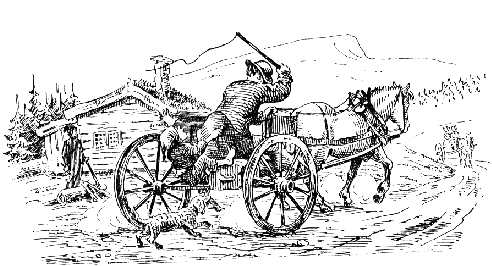
Transport and Inns
 |
Transport and Inns
|
 |
 |
|
Carts were used for rapid transport |
|
All the way back to the middle ages we know of the peasants duty to transport the king and his men. This transport duty became a great burden for the peasants after a while, especially after the nobles and their servants were also granted the right of free transport in 1591.
Abuse of this right led to many complaints from the peasants. In order to counteract this while at the same time creating a system for cheap, private transport a series of laws were passed in the 1600s. This was more exactly formulated in an ordinance dated December 24th, 1648 which established a transport assessment for the entire country of 9 shillings per Norwegian mile (10 kilometers) for a horse. At the end of the 1800s the rate was 12 shillings in the summer and winter, 16 shillings in the spring and fall.
In the olden days, all the way up to 1816, there was the so-called free-transport system for royal officials performing official duties. Whenever the king or his officers were traveling on official duty the peasants were duty-bound to get hold of horses for them. The order usually came by a so-called 'budstikke' or message stick. Eidsivaretten (district court) said that the bishop had the right to 15 horses in the summer and 8 in the winter. There were no limitations for the king.
The local police arranged for the transport. He informed the peasants when military, clerical or other officials were to be transported through the community. Travelers would often go from local police to local police or from priest to priest. At the same time an 'inn' system was established. Even before the end of the middle ages there were resolutions that called for the establishment of inns spaced out over certain distances. These inns "were not restricted to providing travelers with beer, liquor and other necessities of life but also to provide them with transport."
Supplemental to the inns were the 'krohold' which were in reality rest areas for weary travelers along the main roads. If there were no inns present the travelers often went to the local rectory.
After a restructuring of the transport system in 1689 the transport stations were tied to the inns. Transportation was arranged by commanding the peasant to appear at the inn.
With the dawn of the railroad age changes were made in the transport system. The old inns and transport stations which were no longer conveniently located were either abandoned or moved closer to the train stations.
All free transport was abolished in a law of June 16th, 1816. It was replaced by a law for travel compensation for civil servants.
On November 5th 1838 a commission of 5 men was established by the Justice and Police Department with the mandate to revise the current set of laws for the transport system. The changes went into effect on January 1st 1843. The law was based on the resolutions of 1816 but a series of dubious interpretations were cleared up. The new transport law of 1843 presupposed contributions to the transport stations, assessed through the tax roles in addition to state and county subsidies if the station couldn't survive on income from the travelers.
14 Command stations were established in 1861, they were:
Berger (Nesodden), Grønslet (Ski), Soon (Vestby), Sørli (Skedsmo), Kappelsrud (Nittedal), Fetsund (Fet), Årnes og Hektner (Rælingen), Toverud (Aurskog), Kjølstad (Blaker), Larsbråten (N. Høland), Ovind, Tukkebøl og Teig (Enebakk) og Engelsrud (Nannestad).
The districts had to bear the brunt of the cost for the transport stations. This was changed by a law of June 17th, 1869 so that state and county paid 5/6 of the costs, 80% and 20% respectively. The Transport law of January 1st, 1926 changed the relationship of expenses for state and county to 1/2 for the state and 1/4 for the county.
The last six transport stations were discontinued in 1927.
Source: Akershus fylkes veihistorie Oslo 1954 av J. Gjærum
Translated by Steven Mohn, December 1999
Updated January 1st 2000 by The Local History Resource Centre, Fet, NORWAY